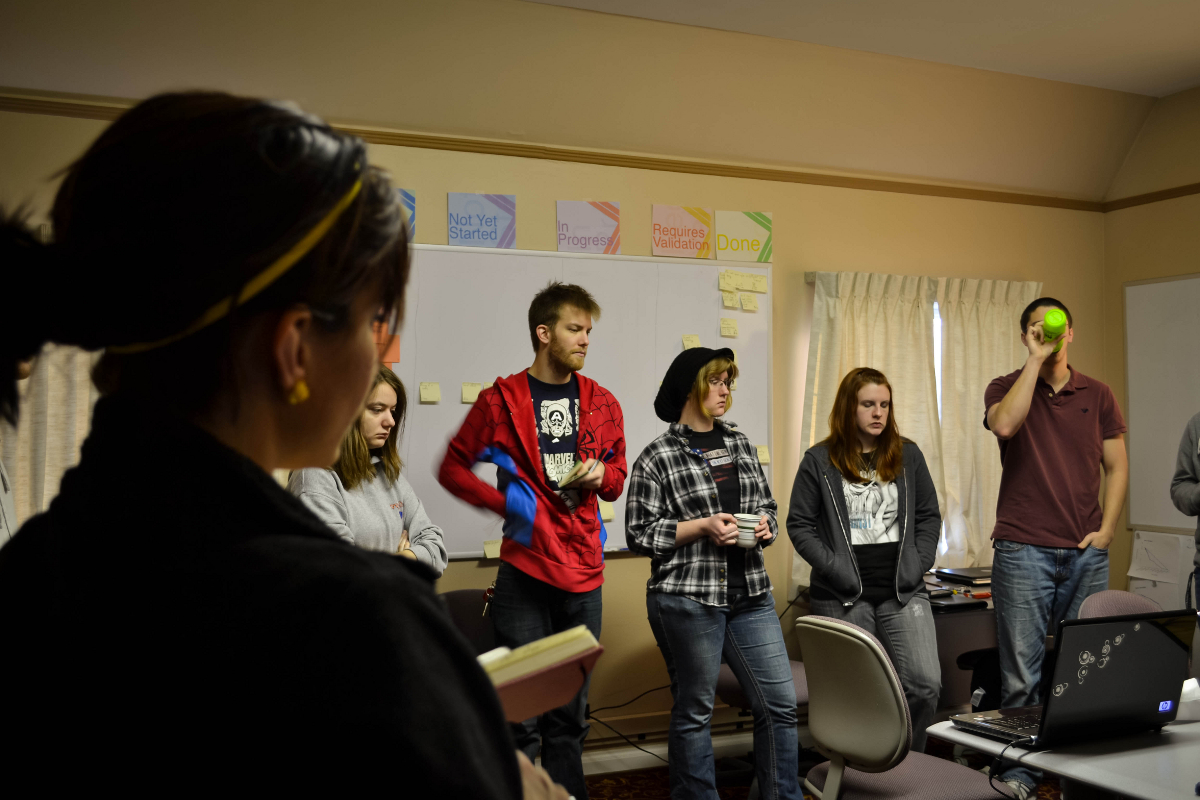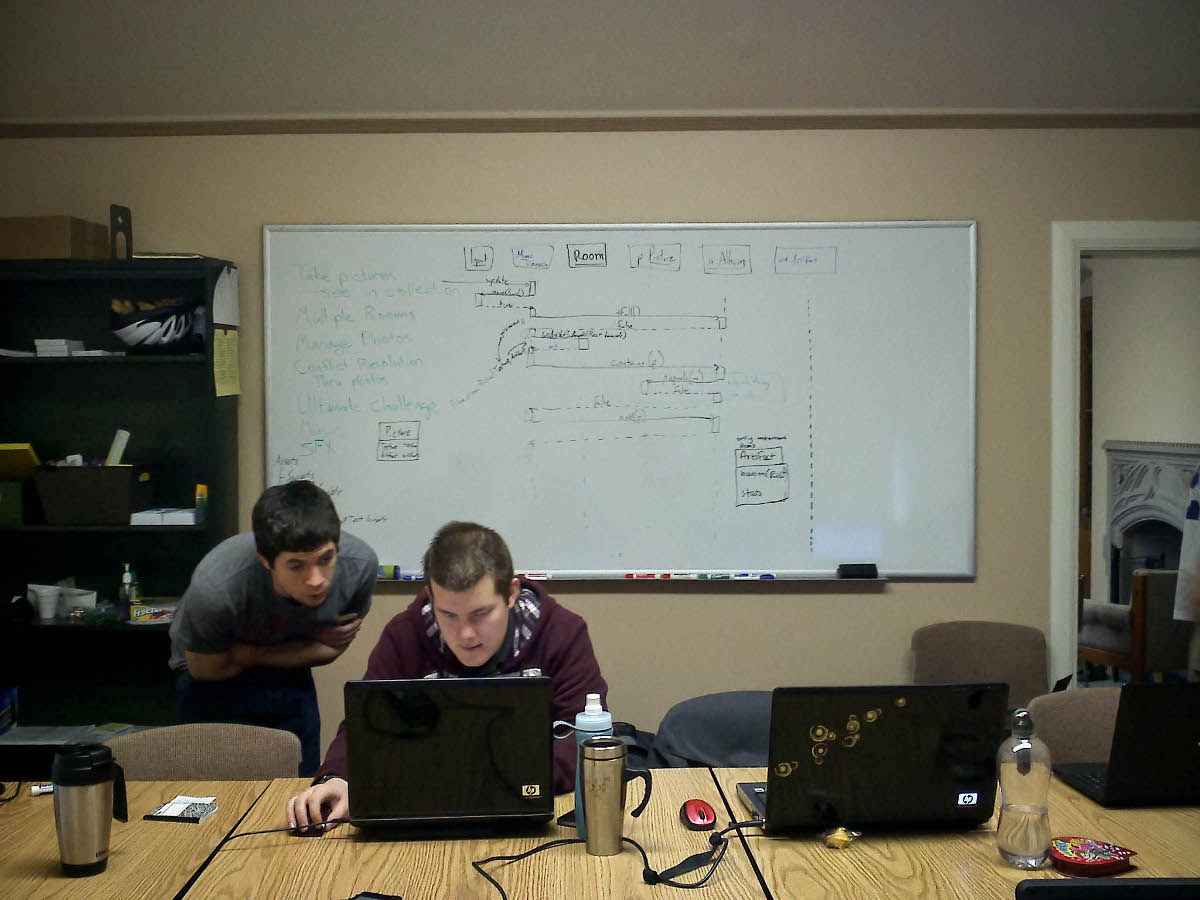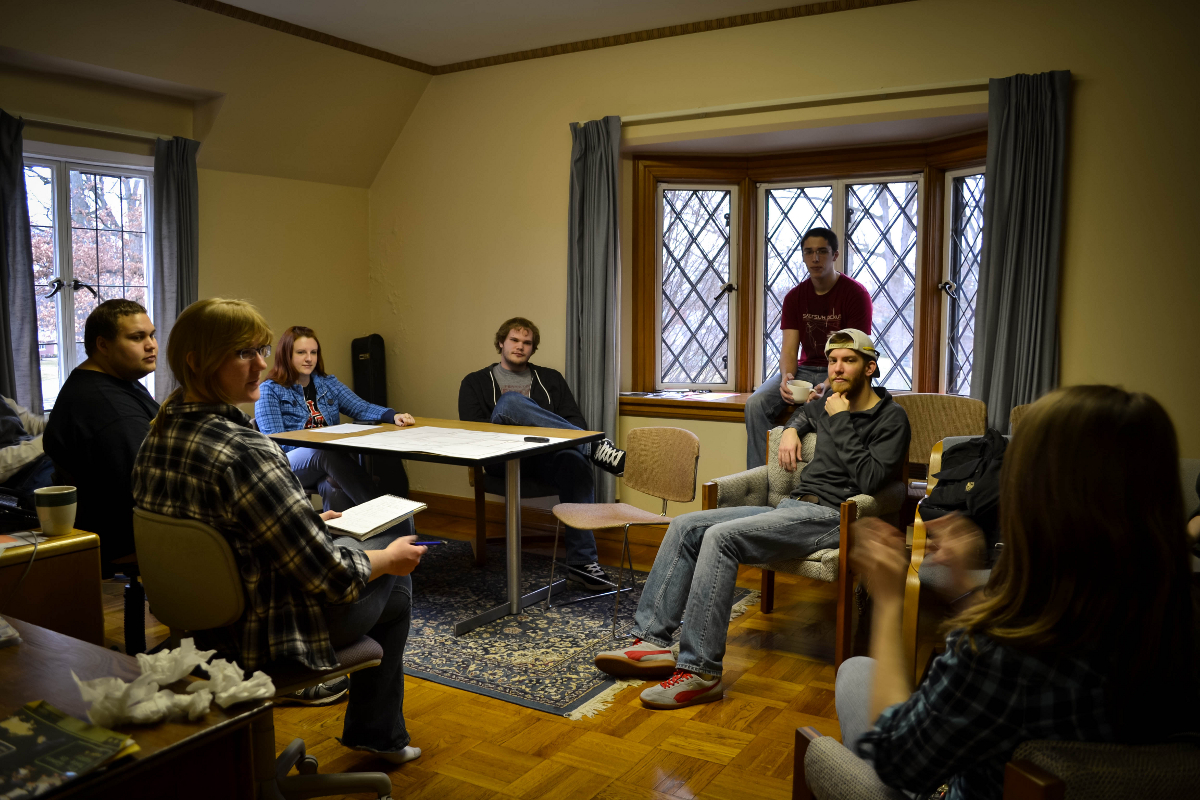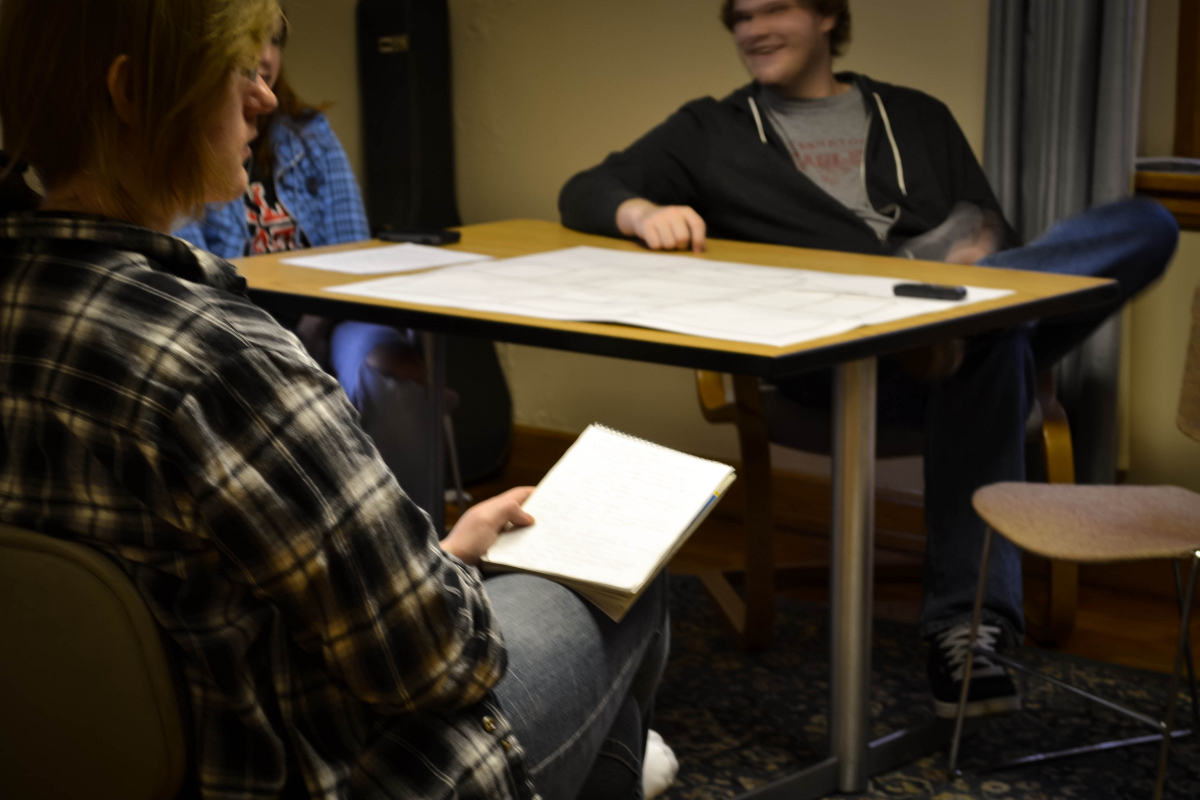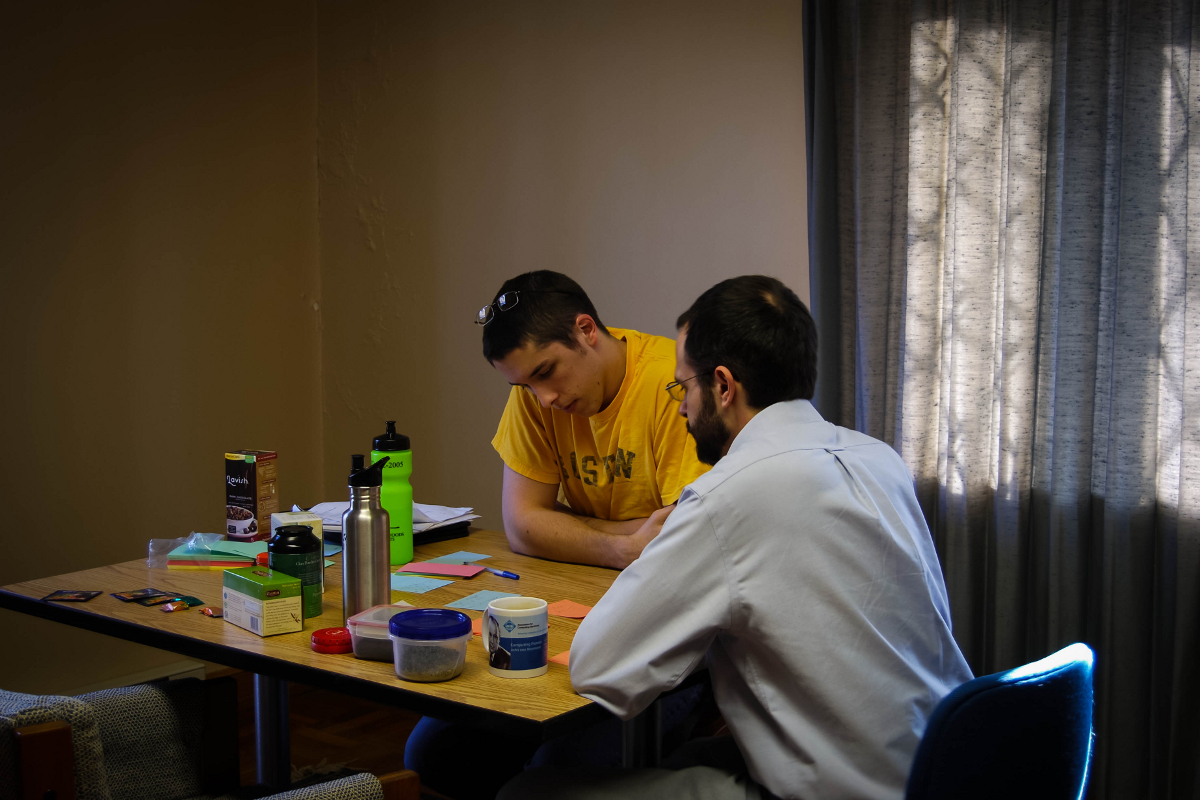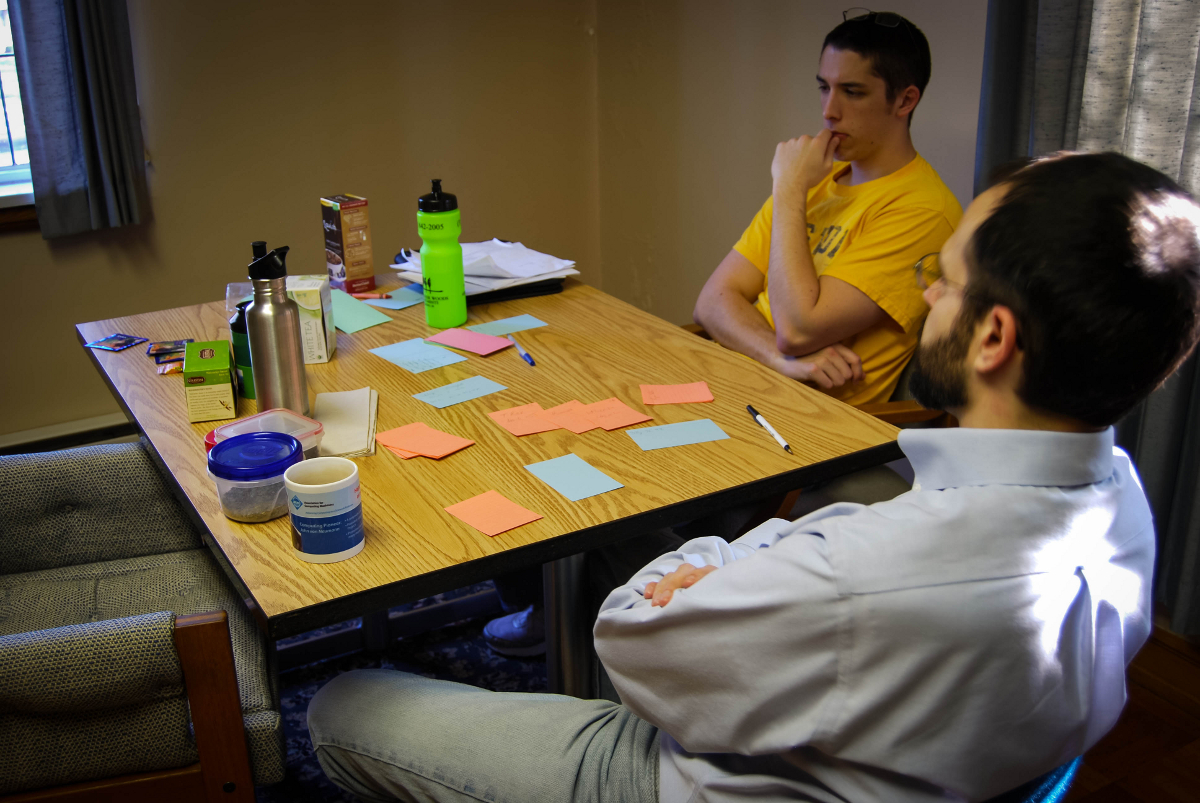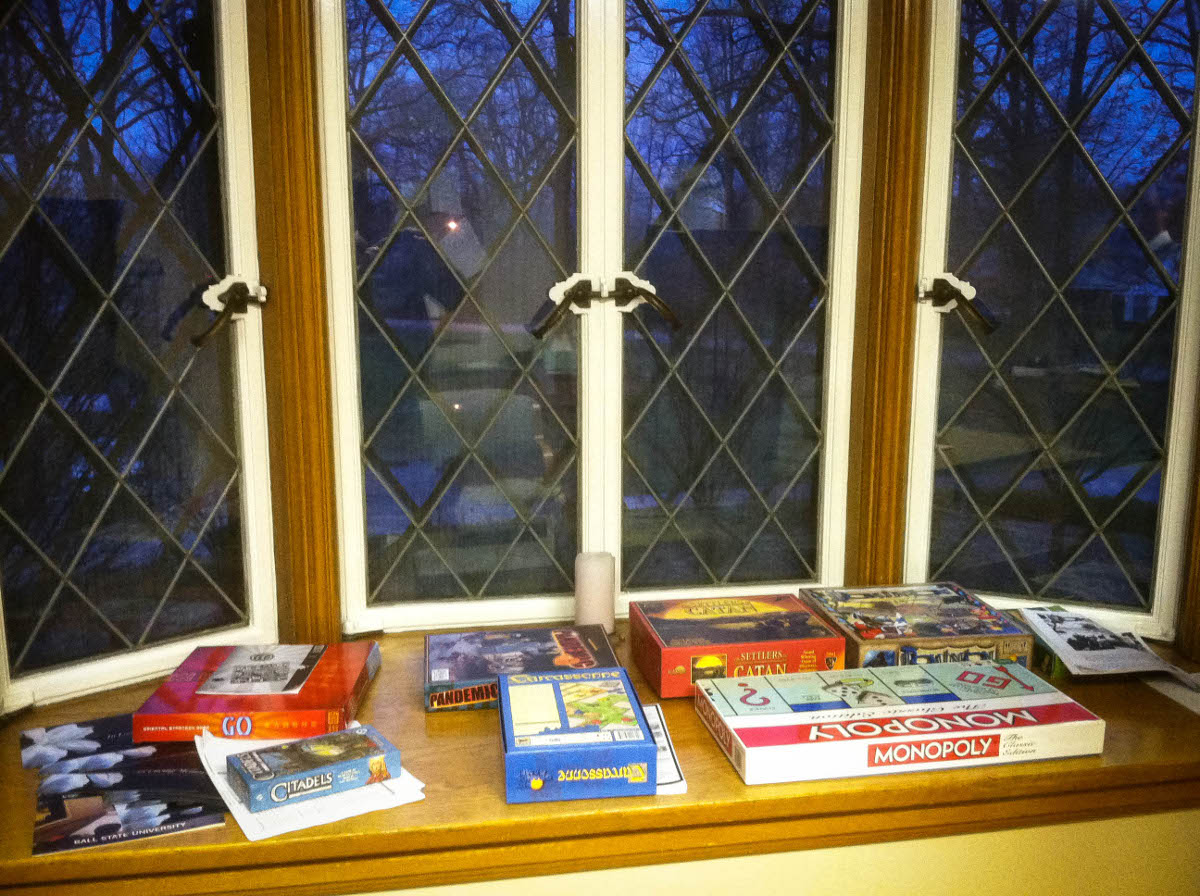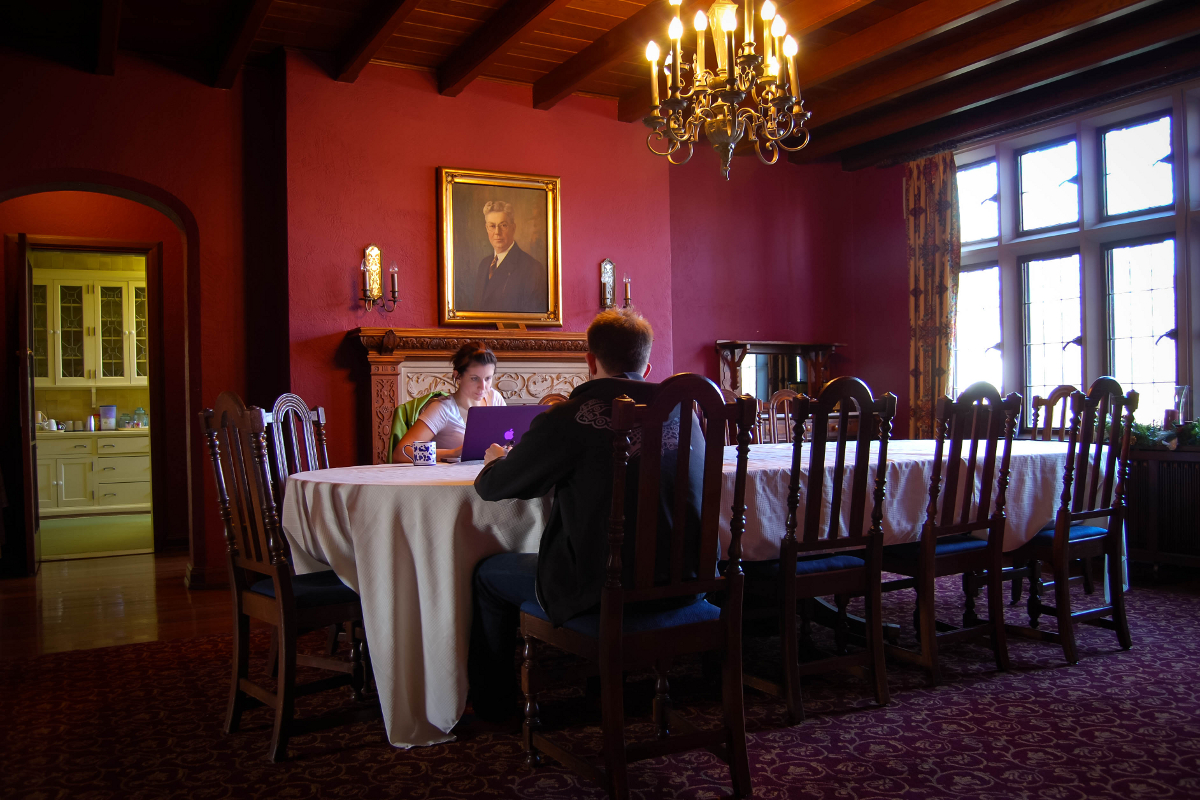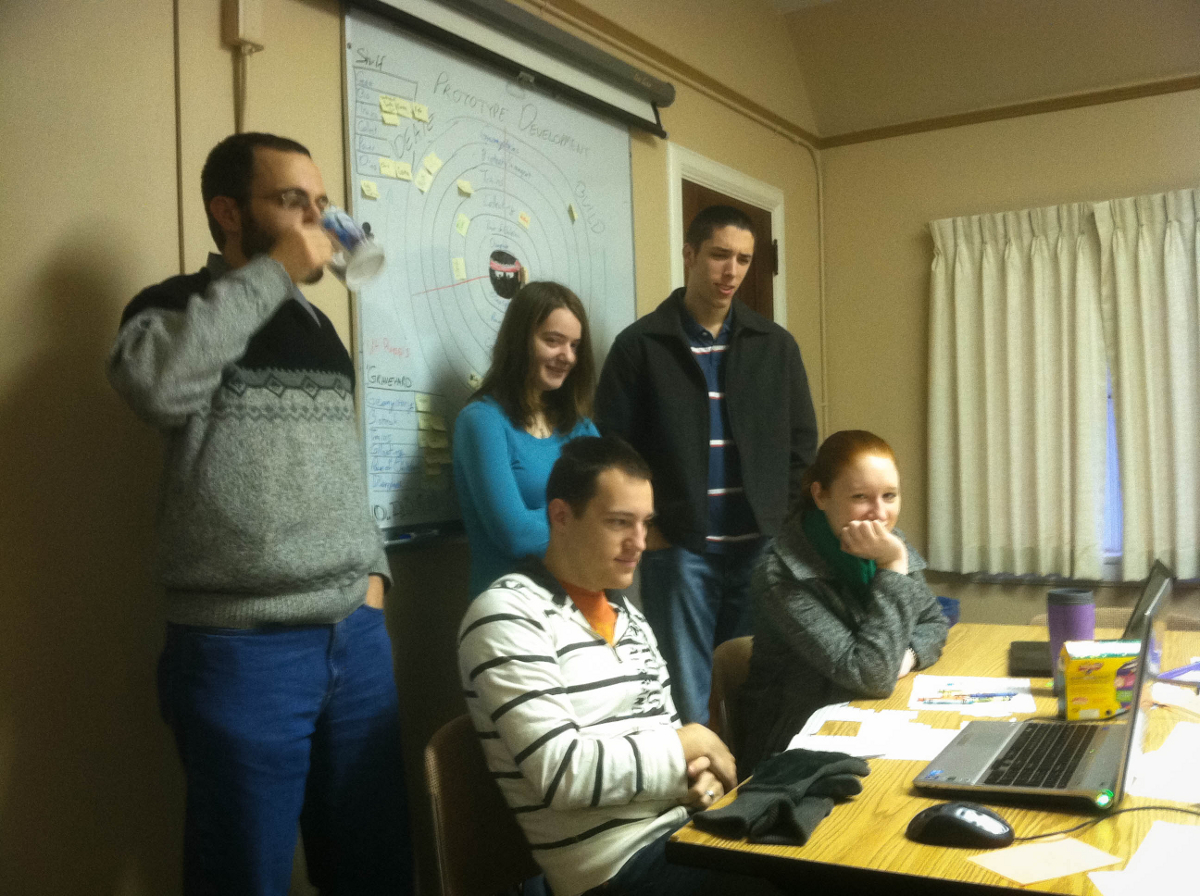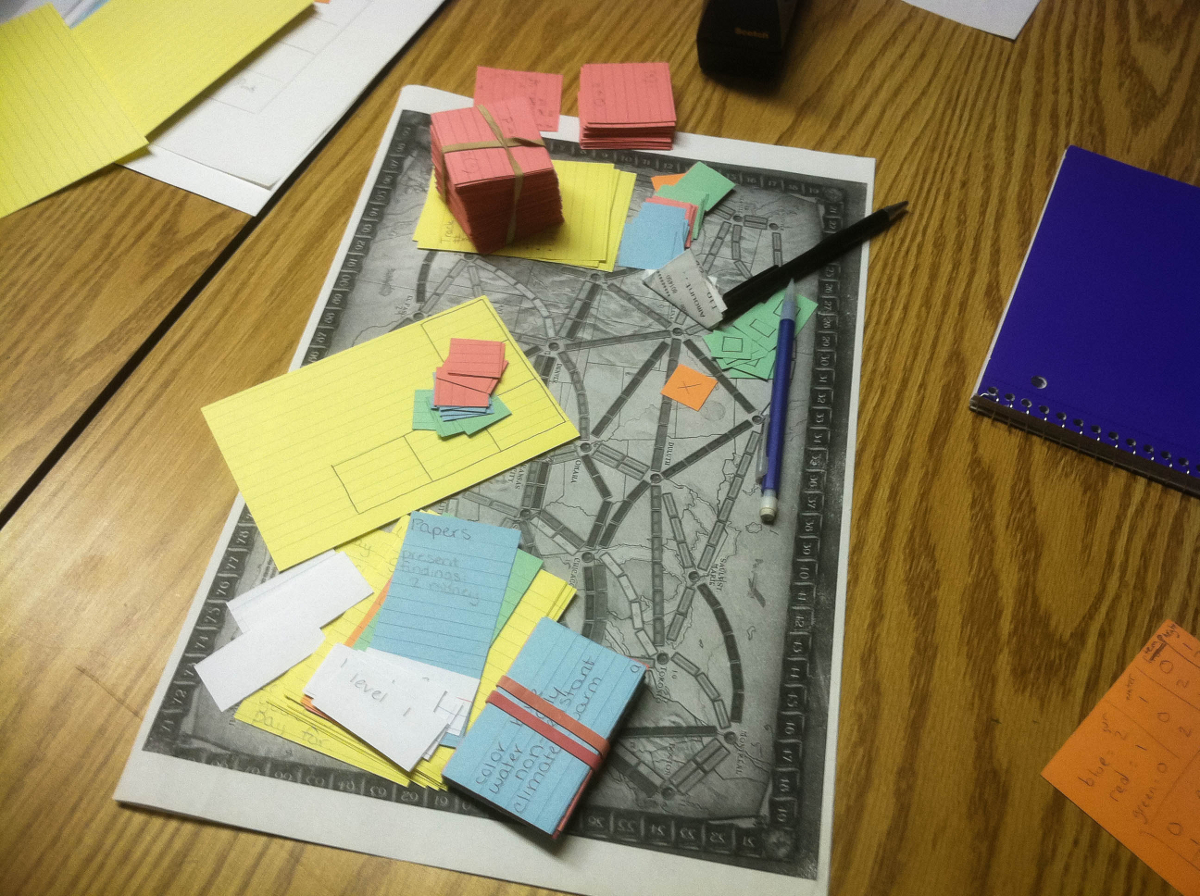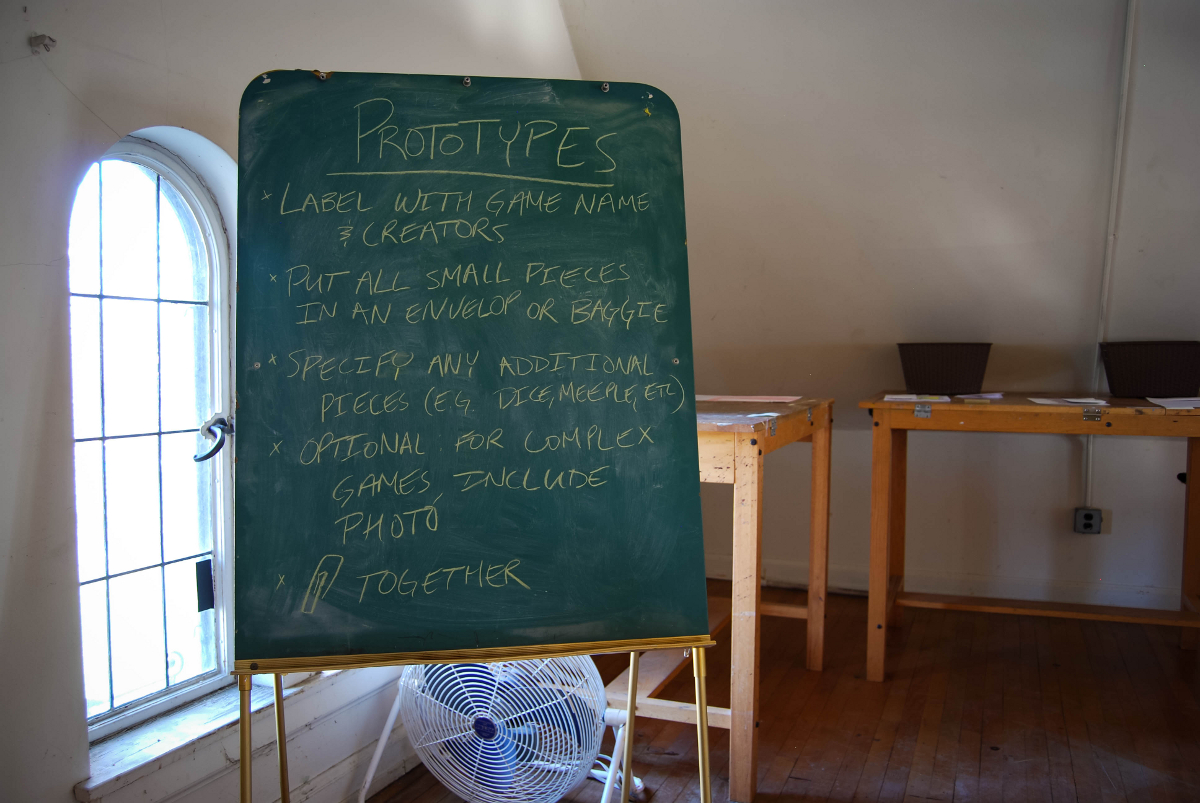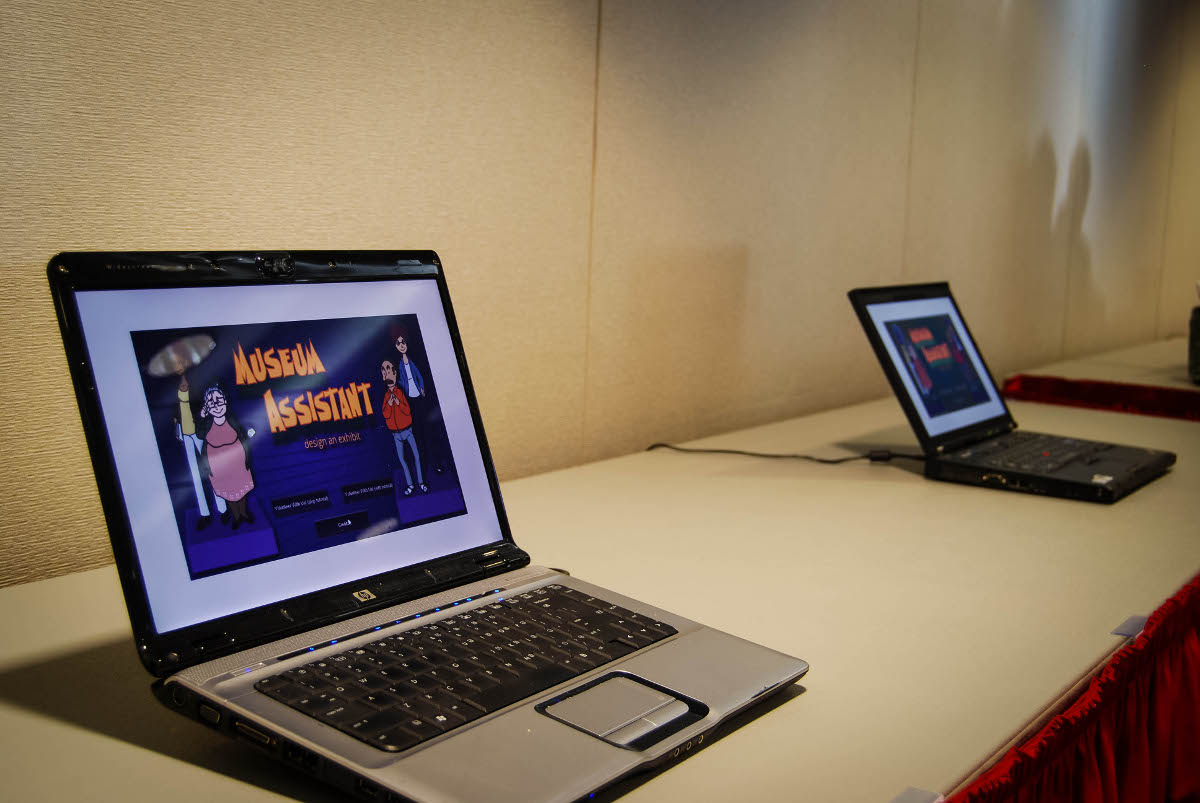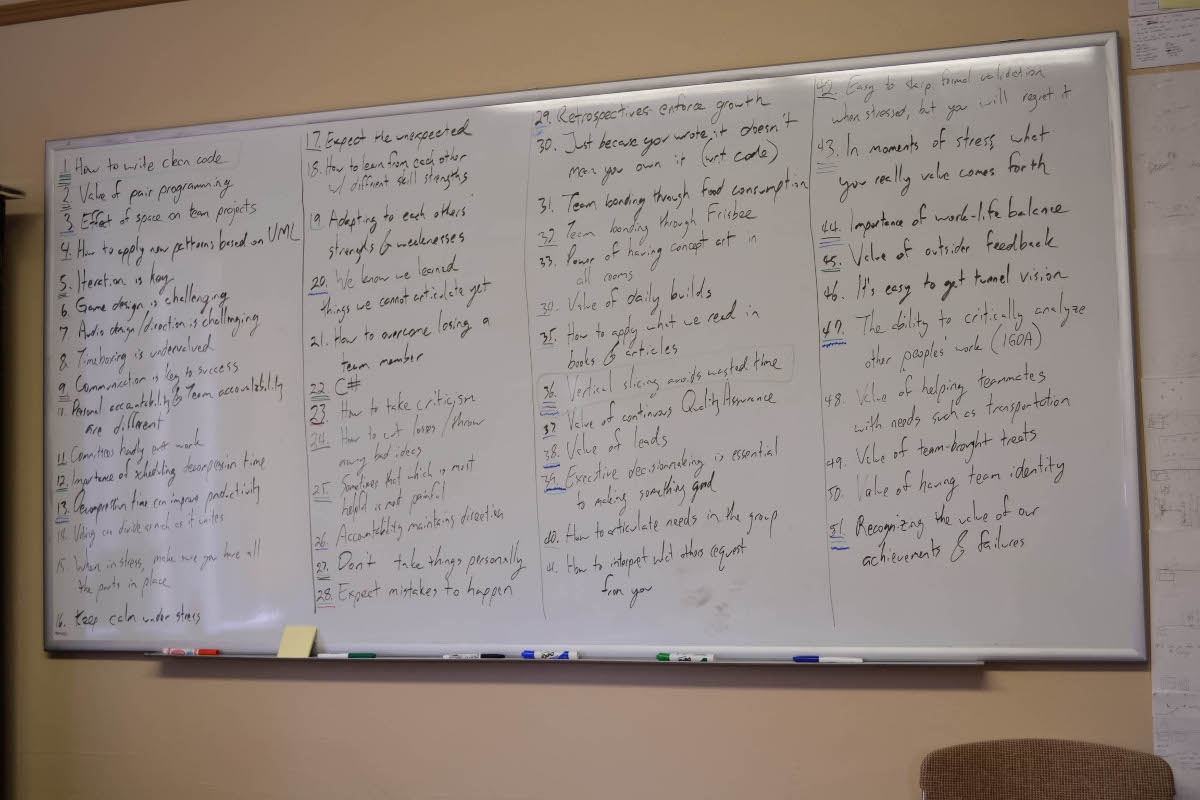Brian J. McNely, University of Kentucky; Paul Gestwicki, Bridget Gelms, and Ann Burke, Ball State University
Enculturation: http://enculturation.net/visual-ethnography
(Published February 28, 2013)
Introduction
Figure 1. Shoes in the foyer.
This image—a pair of shoes, kicked off and haphazardly abandoned in the foyer of an ornate, three story stone and brick mansion built in 1927 in the Midwestern United States—will not carry much meaning for you upon your first viewing. For our research team, however, this image is contextually rich and evocative of a unique collaborative learning and working environment. Situated on a 2.65 acre wooded lot slightly more than one mile from the major university campus that owns the property, this mansion is now a center of intellectual activity and home to a curricular and philosophical approach known as immersive learning. Through extensive fieldwork here over 15 weeks in the winter and spring of 2012, we studied an interdisciplinary group of advanced undergraduate students who designed, developed, and delivered a web-based learning game to their community partner, a nationally recognized children's museum in their home state. Our ethnographic fieldwork gave us a strong sense of our participants’ lived experiences—the everyday work, learning, and play involved in doing game design. And our visual research methods enabled us to document, analyze, understand, and better represent our participants’ interactions in ways that would have been impossible using conventional written fieldwork methods alone. By the end of this article—a visual ethnography of the collaborative work of game development—we invite you to return to this image; we hope that it and many others will evoke a richer understanding of local practice in this uncommon learning environment.
More importantly, we hope that the images and approach of this article will stimulate a scholarly conversation about the use of visual research methods in empirical studies of rhetoric and writing. Our purpose in this article, therefore, is twofold. First, our work makes a broader argument about the use and utility of empirical visual research methods in studies of rhetoric and writing. Beyond germinal work in the reception-oriented traditions of visual rhetoric, we see an opportunity for critical discussion of visual research methods in the field. Despite a long and nuanced history of empirical visual research in anthropology and sociology, such methods have been strangely underrepresented in studies of rhetoric and writing, even as the field has adopted more conventional ethnographic and qualitative approaches from anthropology, sociology, education, and communication studies. Our second purpose is to demonstrate visual research methods through our substantive visual description of learning and doing game development at our research site. As Sarah Pink argues, “appropriate application of visual images and technologies in ethnography may be developed as a force that will bring new meaning(s) to ethnographic work” (Doing 13). We detail here the collaborative inventional work of our participants through prose and images, providing what we hope are both granular insights and new, broader meanings about writing and rhetoric.
Figure 2. Exploring game mechanics through game play (L–R: Ashley, Diane, & Becca).
We begin by exploring traditions of visual research in anthropology and sociology. Empirical visual research methods, we argue, are particularly useful for documenting, understanding, and representing the complexities of writing and rhetorical invention encountered in situ. Additionally, we describe traditions of visual ethnography and briefly compare these approaches with the dominant perspective of visual rhetoric in the field. We then provide more details about our research site, methodology, and theoretical perspective before moving to our substantive visual description of game development among our participants. We explore their work through three interrelated themes: first, we detail practices and spaces of intersubjective genre intermediation. In these examples, participants work with several different written and spoken genres in complex ecologies (Spinuzzi, Tracing), and their work with these genres is both intersubjective—since spatial affordances at our research site enabled frequent, iterative feedback from collaborators—and intermediated—assemblages of genres interoperate and build upon one another in processes of game development. Building on these examples, we then explore spaces of interaction and invention, considering both that which was visibly present in our research site, and that which was notably absent. Finally, we explore the diverse and surprising surfaces of rhetorical invention prevalent in our research site—from slips of paper and 10-sided dice to window glass and touch screens—seeing in and through these many surfaces examples of distributed cognition.
Visual Research Methods
We begin our review of visual research traditions with a simple question: what, exactly, are empirical visual research methods? Claudia Mitchell offers a fairly straightforward answer, noting that a common theme among different forms and perspectives on visual research is seeing “the visual as a mode of inquiry and representation, and as a mode of dissemination and engagement” (5). Luc Pauwels argues for developing a more visual social science, where one “not only looks into visual phenomenon but also tries to integrate visual approaches and techniques in its processes of research and communication” (“Representing” 152). These distinctions are at the heart of visual research methods, for they are formulations of visual inquiry, of using technologies and practices of the visual (especially, but not exclusively: photography, videography, and drawing) to systematically investigate and represent social phenomena.
Pauwels notes that, despite a growing scholarly recognition of a variety of visual research methods in anthropology and sociology, “most social scientists are completely unaware of their existence or potential” (“An Integrated Conceptual Framework” 3). This is an especially interesting claim, given the rich history of visual methods in classic social scientific studies such as those of Gregory Bateson and Margaret Mead, John and Malcom Collier, Howard Becker, and Jay Ruby, among many others. And by the 1980s and 1990s several methods handbooks on visual research were published (see Collier and Collier and Ball and Smith, for example). Qualitative Sociology published a special issue on visual sociology in 1989, and work from Marcus Banks, Gillian Rose, and Pink in the early 2000s provided germinal perspectives on using visuals in qualitative research. Today, visual anthropology and visual sociology are thriving subfields, with journals (Visual Studies, Visual Anthropology), conferences, and scholarly associations. But Pauwels' claim is significant: despite these developments, widespread understanding of visual methods in empirical social science research is sorely lacking.
Notwithstanding such underrepresentation, there are now a wide range of approaches and implementations of visual research in the social sciences. Photography and videography are increasingly used as techniques for engaging participants during fieldwork, particularly because the technologies for doing so are less expensive and more ubiquitous. But there are many other approaches, including participatory methods such as photovoice and photo elicitation (Mitchell; Schwartz; Lapenta), anthropological filmmaking (MacDougall) and rephotography (Rieger). Visual research methods may likewise include participant drawings (Mitchell) and interactive media (Coover), and both quantitative and qualitative content analysis (Bock, Isermann, and Knieper; see McNely, “Shaping” for applications of the latter approach to visuals in rhetoric and writing). Photo elicitation is a common method for exploring participant perspectives in qualitative studies and for collaborative, reflexive meaning-making between researchers and participants, foregrounding photography as a situated and contextual practice rather than an objective record of experience. Dona Schwartz notes that “The tendency to treat photographs as objective evidence ignores the convention-bound processes of both image making and interpretation” (120). Photographs, of course, do not constitute transparent and objective forms of “evidence”; they may be composed, framed, edited, and interpreted in various ways by various constituencies. Schwartz argues that she “consider[s] photographs as inherently ambiguous, their specifiable meanings emergent in the viewing process” (122). Most contemporary visual researchers complicate the ontological properties of photographs, videos, and drawings, taking a reflexive approach to the visual (see, for example, Pink, Doing, 2nd ed.; Mitchell).
Jon Wagner’s 1979 call for visual methods in qualitative research argued that there were, at the time, “too few visual studies of people acting in natural settings,” and that even when we have images of lived experience, we know far too little about how people interpret visual representations of their own situatedness (286). Practices of visual ethnography attempt to address these issues, and more. Pink's 2001 Doing Visual Ethnography and her 2007 second edition are germinal in this regard. Recounting the epistemic crisis in anthropology during the 1980s, Pink suggests that the disciplinary debates of that time “paved the way for the visual to be increasingly acceptable in ethnography as it was recognized that ethnographic film or photography were essentially no more subjective or objective than written texts” (Doing 1). Pink argues that the visual methods manuals published before this epistemic turn “propose problematically prescriptive frameworks that aim to distance, objectify and generalize, and therefore detract from the very qualities and potentials that the ambiguity and expressivity … of visual images offers ethnography” (Doing 3). She argues instead for a visual ethnography that is reflexive and subjective, that “recognizes the interwovenness of objects, texts, images and technologies in people’s everyday lives and identities” (Doing 6). Reflexive visual research methods, therefore, aim “to explore how all types of material, intangible, spoken, performed narratives and discourses are interwoven with and made meaningful in relation to social relationships, practices and individual experiences” (Doing 6). As a methodology, visual ethnography “involves the ethnographer’s reflexive engagement with the ways of what Lave and Wenger see as ‘knowing in practice’ … produced at all stages of the ethnographic process” (Pink, “Mobilising” 2).
In contemporary studies of rhetoric and writing reflexive empirical methodologies are the norm (see, for example, Kirsch and Sullivan and Mortensen and Kirsch). Systematic qualitative case studies of written communication and ethnographies of rhetorical practice have substantially shaped our field's perspectives on knowing and being in and through writing and rhetorical work. And yet Pauwels’ claim about the lack of understanding and implementation of visual research methods in anthropology and sociology could be similarly applied to empirical studies of rhetoric and writing. In spite of a strong visual turn in our field, visuals are rarely used meaningfully in empirical studies of writing and rhetoric—as “integrate[d] visual approaches and techniques in [the] processes of research and communication” (Pauwels, “Representing” 152). There are notable exceptions, of course: Prior and Shipka have productively used participant drawings, Spinuzzi's (Tracing) fieldwork includes illustrative images, Geisler and Slattery have each made extensive use of screen capture techniques, and Sauer's ethnography of miners includes photographs which help her interrogate gestural rhetorics. To our knowledge, however, there are no visual ethnographies of rhetoric and writing, and few qualitative studies that deploy visual research methods as a primary mode of inquiry in systematic, empirical investigations of writing and rhetorical practice. This seems profoundly odd, given that—to paraphrase and adapt Ellen Lupton’s statement—writing is what language looks like.
Instead, the dominant perspectives on visual inquiry in our field are generally reception-oriented, drawing on traditions of social semiotics and cultural studies rather than empirical approaches more common in the social sciences (see, for example, Hill and Helmers and Handa). Given our field’s historical associations with the humanities—and indeed, the number of influential scholars in rhetoric and writing with training and specialization in cultural studies—this is unsurprising; and yet given our field’s widespread contemporary adoption of qualitative research methods, this development is especially curious. As Pink (Doing, 2nd ed.) has argued, “the focus in cultural studies is on interpreting existing images and objects and the social and cultural conditions within which they are produced, rather than on how images and their production form part of ethnographic practices” (14). Pink’s more recent work “consider[s] the potential for combining multimodality and anthropologically informed sensory ethnographic methodologies” (“Multimodality” 261). However, phenomenological anthropology and multimodality, she argues, “are based on fundamentally different theoretical premises and methodological approaches” (262), and she has difficulty in reconciling the two methodologically. We have neither the space nor the inclination to similarly explore the potential for combining visual rhetorics and visual research methods in this article; instead, we argue here that the latter are strangely absent in our field, and that they can help scholars of rhetoric and writing develop significant new insights about our objects of study.
We have therefore chosen to foreground our visual research methods in this article because they help us better understand and represent the ephemeral and interstitial work of rhetorical invention. As you will see, our participants did so much inventional, coordinative, and collaborative work across so many surfaces and genres of rhetorical action that visual forms of inquiry are really the only appropriate methods for meaningfully documenting, learning about, and representing such phenomena. We have made a concerted effort to use photography rather than videography for two primary reasons: first, as a practical constraint on our field research, we collectively had more experience working with the production and analysis of still images than video; second, and more importantly, we viewed photographs as affording both a medium through which we might better understand and analyze participant knowledge (in granular moments and as a collective whole), and as a mode of representing the complexity of our participants’ work. Our visual methods, therefore, helped us better understand the many genres of writing and rhetorical action that comprised participants’ eventual, public work. For our research team, the visual was thus an important way of knowing and being with our participants. Aside from one group image (Figure 3, below), none of the photographs you will see in this article were staged in any way (though they are certainly composed and framed). They have been lightly edited for clarity and sharpness, and in a few cases, cropped for better representation of rhetorical work. We otherwise present these images as a way of seeing and being with our participants in the work of collaborative game development.
Figure 3. Root Beer Float Studio: our participants and their faculty mentor.
Methods
In this section, we detail the salient contextual features of our research site, the everyday learning and working environment in which our research team was embedded, and the curricular and administrative infrastructure known as immersive learning that fostered this unique space of undergraduate student interaction. We also describe our participants and the general learning atmosphere that we observed during our fieldwork. Finally, following Peter Smagorinsky, we detail our research questions, our methodological approach and concomitant theoretical perspective, and we provide an accounting of our data collection, reduction, and analysis procedures.
Immersive Learning
Our study was conducted at Ball State University, a large research university in the Midwestern United States that consistently fosters what George Kuh has called “high impact educational practices.” The university administration systematically encourages and supports several forms of experiential learning within the curricula of its colleges and departments. Indeed, the university has come to define its own brand of high impact educational practice called immersive learning. As both a philosophy of learning and a curricular approach, immersive learning is characterized by academic-professional partnerships that fuse traditional curricula and skills development with societal needs, typically within the State of Indiana. In this way, immersive learning curricula results in tangible, actionable deliverables that range from business plans or policy recommendations to innovative digital projects, films, and books. Immersive learning experiences are student-directed and faculty-mentored, and they are strongly focused on student learning outcomes. By design, these experiences often serve as entry points into a student's chosen profession, and immersive learning projects always involve interdisciplinary teams.
Figure 4. A reading group discussion in the parlor of the Virginia Ball Center for Creative Inquiry.
One of the longest standing immersive learning experiences at the university takes place at the Virginia Ball Center for Creative Inquiry. The center, roughly one mile removed from campus, is located in a three-story mansion on a large, wooded lot in a residential neighborhood—physically and philosophically distinct from the bustling university. In this idyllic location, two different 15-credit seminars run during the fall and spring semesters each year, literally immersing students in a single, extended, interdisciplinary project led by a dedicated faculty member whose sole commitment is to the seminar that he or she leads. Students and faculty mentors, then, are expected to focus full-time on a single project, and to generate tangible, meaningful outcomes in concert with a community partner. Participants in our study partnered with the premier children’s museum in their state, with the goal of developing a web-based learning game that would help the museum update some of their dated web properties, while also teaching children—through meaningful play—about the museum and its holdings.
After an application and interview process, 13 students were selected for enrollment in the seminar we observed, and all of them agreed to participate in our study. We worked with six female and seven male participants, the youngest of whom was 19 years of age during the semester, while the oldest was 26. The average age of participants was 22, and for 4 participants, this immersive learning seminar was to be their last academic work before graduation. Seven participants were computer science majors, while the remaining participants listed visual communication, music technology, theater studies, history, accounting, and animation as their first major. We believe that the overall maturity and earnestness of this group of participants was a key factor in their ability to coordinate complex, interdisciplinary work using agile software development techniques, several of which were new to the majority of participants (including some of the computer science majors). Upon visiting the seminar midway through the semester an outside observer might assume that participants comprised a professional software development team, since neither daily practices nor the learning environment resembled any kind of traditional classroom. Indeed, the overall atmosphere was of a game development studio, and the absence of traditional artifacts, spaces, and practices of higher education is a theme that we take up in more detail later in this article.
Visual research methods, we should note, carry an increased ethical responsibility among field researchers. The act of obtaining informed consent, Pink notes, does not give researchers license to use images and videos in unrestricted ways (Doing, 2nd ed., 54). In addition, as Mitchell has argued, photographs of potentially identifiable places and spaces—even when they contain no people or easily identifiable artifacts—are potentially problematic when it comes to issues of participant confidentiality in representation and dissemination. While developing protocols for research with visual methods pose no unusual difficulties for most Institutional Review Boards (IRBs) (assuming that the research is not conducted among a protected population), a clear understanding about the use of visuals between researcher and participant must be developed, especially because, as Pink notes, ethical research practices are tightly bound together with power issues—among researchers, participants, organizational stakeholders, sponsors, et al. (Doing 2nd ed., 49). In this project, discussions about visual methods occurred throughout—both as part of an ongoing dialogue concerning our study, and as a key component fostering our understanding of participant experience. In addition to the typical informed consent documentation and discussion about video, audio, and photographic data collection, storage, and dissemination, we also secured media releases as part of the broader immersive learning context. For this project, we use our participants’ first names and identifying images with their express permission. Indeed, we have shared many of these images with our participants, and we have used several of them to foster discussions. In our view, the images presented here do no harm to participants; in addition, they provide a much more detailed sense of participant experiences than could our written reconstruction alone. Most importantly, our participants are justifiably proud of their work, and they have been eager to see broader visual and written discussion of their project.
Inquiry, Methodology, and Theoretical Perspective
Our research team’s efforts were guided by a simple line of inquiry: what do students “get out of” immersive learning experiences, and how are these experiences qualitatively different from traditional learning environments? We were particularly interested in the role of writing (in both informal and formal genres), communication (especially informal and coordinative verbal and gestural communication), and collaboration in mediating such experiences. In order to develop potential answers to our research question, we designed an ethnographic protocol that placed a significant emphasis on being actively embedded at our research site as much as possible, using a variety of means to document our fieldwork (these are enumerated below). Four researchers spent almost 135 collective hours in the field, across 83 separate observations over 15 weeks (McNely was principal investigator, while Gestwicki, as faculty mentor for the seminar, was not involved in data collection and had no knowledge of student participation until after the semester had ended; McNely, Gelms, and Burke conducted the majority of fieldwork, assisted at times by an undergraduate researcher, Chase Skiles). Our ethnographic methodology and extensive fieldwork yielded rich, granular data about the lived experience of participants, and strong tacit understanding of practices at our research site (see also McNely, et al., and Gestwicki and McNely for further details on our work with this group of participants).
Our methodology was framed by a specific theoretical perspective: studying situated, collaborative work and learning as the tool-mediated, goal-directed practices of people acting with technologies (see, for example, Nardi; Bazerman and Russell; Spinuzzi, Tracing; Engeström, “Innovative Organizational Learning” and “Innovative Learning”; Kuutti; Bødker; and, especially, Kaptelinin and Nardi). From the perspective of cultural-historical activity theory, activities are complex social and societal practices oriented toward specific objects; in our study, participant objects included the collaborative development of an effective and entertaining children's learning game, professional skill development and experience, and meaningful collaboration with the community partner. From this theoretical perspective, people collaboratively construct objects by using various mediational means specific to their contexts and the discursive norms of their community and larger culture. These mediational means may include specific artifacts, tools, and symbol systems. During fieldwork, this led us to focus on social and historical practices involving many interrelated actions (conscious, goal-directed practices that have discernible beginning and ending points) and operations (largely unconscious, routinized practices that often comprise actions). We were especially attuned to participant processes—how they routinely do things with the mediational means at their disposal, in the service of broader objectives. In our fieldwork, photography and written fieldnotes were our primary means of documenting such processes.
The perspective of cultural-historical activity theory has been productively adapted to studies of writing and rhetoric, most significantly by David Russell (“Activity Theory,” “Rethinking Genre,” “Writing and Genre,” and “Uses of Activity Theory”) and Clay Spinuzzi (“Compound Mediation,” Tracing, “Four Ways,” and “Secret Sauce”). Both scholars have begun to use the term writing, activity, and genre research (WAGR) to describe the confluence of work in activity theory and rhetorical genre studies (cf. Bawarshi and Reiff), and our work is substantially informed by this scholarship. In WAGR, genres are not only typified, tool-mediated responses to recurrent problems, they are ways of being in the world that have proven useful in situated activities (“Uses of Activity Theory” 43). The genre knowledge of participants thus mediates everyday practice such that, from a WAGR perspective, genres make certain kinds of interaction possible (Russell, “Uses of Activity Theory” 45).
As Spinuzzi (“Four Ways”) argues, “Genres have proven to be valuable particularly in studies of work and learning, since they help researchers to conceptualize and study how people produce and interpret artifacts” (115). Most importantly, one’s perspective on genre simultaneously carries crucial methodological implications, for as Spinuzzi contends, “choosing a framework means choosing a set of phenomena to highlight” (“Four Ways” 115; emphasis in original). We adopted Spinuzzi's genre ecology framework (Tracing, “Four Ways”), an approach that sees assemblages of genres as mediating practice in complex and dynamic ways—as co-constituted and evolving instantiations of both informal and formal genres. From this theoretical approach, therefore, interstitial and ephemeral forms of genre knowledge and practice (such as informal conversations between participants who are pair programming or notes jotted quickly on a whiteboard, only to be erased a few minutes later) were key phenomena for our research team, for they help reveal everyday infrastructures of collaborative work and learning.
Data Collection, Reduction, and Analysis
In order to systematically and effectively observe and record these forms of everyday phenomena at our research site, we deployed several means of data collection. In the interests of robust triangulation, we collected data in multiple forms, across multiple visits, across multiple participants, and from the perspective of multiple researchers, resulting in documentation of a rich matrix of phenomena which substantially constituted the learning and work of game development at our research site. We began data collection in mid January, 2012, and concluded our fieldwork in late April, 2012. Overall, our 83 site observations resulted in many individual data events across six major types:
- Fieldnotes and Analytic Memos: we generated nearly 170,000 words of fieldnotes that were focused on both individual and collaborative practices, tool mediation, and participant lived experience. We produced in-process analytic memos as well, resulting in 24 reflections and syntheses of observed practice.
- Audio Recordings: we gathered 45 audio recordings of daily status meetings, review sessions, ad hoc collaboration sessions, and impromptu interviews.
- Interviews: we conducted three rounds of semi-structured interviews with participants; these interviews focused on how participants viewed their own practices and those of others, how they viewed their work in relation to traditional curricula, and how they used a variety of mediating tools in everyday practice.
- Artifacts: we collected over 150 participant-produced artifacts (written documents, design objects, artwork, and images).
- Photographs: we composed 422 photographs during our study; these photographs were essential for tracing ephemeral and ad hoc writing practices, and for understanding spaces and surfaces of interaction.
- Videos: we collected two videos of daily status meetings and one video of pair-programming practices.
This level of data collection fostered triangulation across data events and participants as well as strong tacit understanding of participant practices among our research team.
In traditional ethnographic and qualitative reporting, a premium is often (and perhaps unintentionally) placed upon the discursive data collected and generated at a given research site—on fieldnotes, analytic memos, and especially transcriptions of participant interviews, for example (cf. Packer, and Pink, Doing). In such reporting, if images and participant artifacts are generated or collected, they may be marshaled as support for triangulating insights derived primarily from discursive data—if they are mentioned at all. As we argued above, however, our approach to data reduction and analysis is to invert this tendency: rather than seeing visual data as supporting fieldnotes and transcriptions, our analytic perspective is to begin with the visual data as the primary ground of analysis, drawing on fieldnotes, analytic memos, and interview transcripts for triangulation and additional context. As such, the 422 photographs that we composed during our fieldwork comprises the reduced dataset that we discuss in this article; we draw from fieldnotes, memos, and interview transcripts as triangulation measures where appropriate. In this way, we are able to share much more primary data with readers than would be possible in a narrative that overwhelmingly privileged discursive data; included in this article are 135 of the 422 images, 32 percent of the photographic data we generated in situ.
Genres, Spaces, and Surfaces—Game Development in Practice
Following Anselm Strauss, the goal of our methodological approach in this article is to provide a substantive description of participant experience in the learning and work of collaborative game development. But we see this project as updating Strauss, for we provide a substantive visual description of our research site and the everyday genres, interactions, artifacts, spaces, and surfaces that were materially and symbolically meaningful to our participants. This description takes the form of three themes inductively derived from a systematic analysis of the visual data we generated in situ. In the following sections, we make our arguments in written form and in images—a visual ethnography of participant experience.
Spaces and Practices of Intersubjective Genre Intermediation
As we suggest above, artifacts, tools, symbol systems, historical contexts, cultures, and discursive norms combine to shape what it means to do the everyday work of game development. Spinuzzi (“Compound Mediation”) uses the term compound mediation to “refer to the ways that people habitually coordinate sets of artifacts to mediate or carry out their activities” through an ecology of genres (98). Stated another way, an individual's genre ecology itself mediates activity in a given work or learning scenario rather than individual tools (100). More importantly, Spinuzzi's genre ecology approach and WAGR perspective not only foregrounds the work of individual ecologies (how one person might draw on several genres in a process of compound mediation), it highlights the need to compare different mediatory systems. Multiple genre ecologies are operative in working environments such as the one we studied; a computer science student may have a very different genre ecology than a music technology major, for example. And yet, in the collaborative work of game development, these respective genre ecologies will inevitably come into contact with one another, intermediating various genres. Genres, genre practices, and genre knowledge thus interact, overlap, and may even contradict one another or form new, hybrid assemblages. And in our research site, the Scrum board (see Figure 5), as we have discussed previously (McNely, et al.), acts as a powerful orienting genre—an ever-visible surface for mediating and intermediating genres of work from across the development team.
Figure 5. An early version of the Scrum Board on February 2nd, 2012.
Scrum (see Schwaber and Sutherland) is a project management framework for “developing and sustaining complex projects” (3). It is commonly incorporated into agile software development practices, and it was the primary organizational structure in use among our participants; in addition, specific genre ecologies were partially framed by Clinton Keith's recommendations. The team we studied worked in two-week increments called “sprints.” Game features were articulated as user stories, which are short statements of value that foster communication between the team and stakeholders (Mike Cohn); the coordination of team and stakeholder design decisions is described in Gestwicki and McNely. The team was responsible for articulating the tasks necessary to satisfy each user story and for tracking these tasks throughout the sprint. User stories and tasks were given material, written representation through large index cards and smaller sticky notes, respectively. These artifacts were placed on the Scrum Board and thus served as continuous reminders of task progress during a given sprint (see Figure 5).
At the end of a sprint, the potentially deliverable products were reviewed by the team and faculty mentor. During the course of our participant team’s seven sprints, these products included paper prototypes, concept art, design documentation, event plans, digital prototypes, and the final, shipped software. Scrum thus coordinates user stories and the various tasks necessary for addressing a given user need, and participants oriented to the Scrum board continuously throughout a sprint. Each task may be accomplished, therefore, by one or more persons bringing one or more genre ecologies to bear on the work. At the team level, then, the Scrum board was a key factor in coordinating complex genre intermediation. The following images show how the Scrum board was used by participants during several of the sprints.
Scrum Board Development: Figures 6–12.
While the Scrum board helped coordinate collaborative activity among and across team members, it is only one aspect of genre intermediation. We move now to a more detailed example by following Lauren, a visual communication major, as she worked through a paper-prototyping task in mid-February.
Figure 13. Lauren storyboarding game play and user interface details on February 17th, 2012.
Figure 14. Lauren storyboarding (detail) on February 17th.
At this stage of development, a Friday morning during the first week of a sprint, Lauren is working hard to finish a playable paper prototype. In an informal interview we conducted during a break in this activity, she told us that she wanted to know whether or not a given aspect of the game is valuable at this point—something that would be discoverable through playtesting of the prototype. She said “We also want to have this whole thing being able to be designed next week.” When asked to elaborate on what she meant by “designed,” she noted that her sub-team—including Nick, Diane, and Ashley—wanted to have a functioning paper prototype that would meaningfully inform digital development the following week. Such development would in turn lead to new artistic tasks for participants like Lauren and Diane. We note that this group of students constituted what is known as a cross-functional team, in accordance with the best practices of Scrum (Cohn; Keith; Schwaber and Sutherland), and that the resultant interdisciplinary design objects gave rise to work in more conventional disciplinary genres.
Figure 15. A part of Lauren’s genre ecology during storyboarding.
Figure 16. A part of Lauren’s genre ecology (detail) during storyboarding.
We can see in Figures 15 and 16 that Lauren deploys several genres during her storyboarding work: she is responding to tasks she personally negotiated (and that are visible for others on the Scrum board); her work is shaped by informal verbal interactions from Nick, Diane, and Ashley; she can consult personal notes residing in her moleskine and mobile phone; she has a sketchbook for user interface designs; she has a series of index cards that will ultimately be used in a playable prototype; and her work here will eventually lead to whiteboarding notes, artwork, and digital prototyping. In addition to the artifacts and tools ready to hand, Lauren's work is intersubjective in several ways, and her genre practices become intermediated through collaborative work with (especially) team members in playtesting and digital prototype development. Indeed, a feedback loop of intersubjective genre intermediation is fostered by the iterative development practiced at our site. Genres such as paper prototypes with user interface sketches are deployed and tested; paper prototypes are adjusted and redesigned based on feedback; digital prototyping picks up (see Figure 17) and is itself intermediated by further playtesting of the paper prototype; and this loop is all the while lubricated by interstitial and ephemeral genres of practice—whiteboard notes, moleskine sketches shared among team members, one-off verbal feedback from someone passing through…
Figure 17. Ashley’s Laptop, detailing end-of-sprint digital prototyping on February 23rd, 2012.
Participants were keenly aware of interdependencies (and genre ecologies) among sub-teams working on different aspects of development. Lauren details some of these interdependencies (and genre intermediation):
Everything we decide kind of pulls strings of the web to everything else in the game. So, whatever they decide that the prototype game they're doing in the attic [another sub-group] is affecting what we're doing, and what we're doing is affecting what the computer science—digital versions are doing. So we can't really proceed without decisions from the whole team, but neither can the other subcategories [of the game development] proceed until we have made decisions.
Finally, space matters. This is a commonsensical claim, but no less important for its simplicity. That Lauren had the space to be creative, that she had the tools ready to hand to do so, and that others could see her work and interact with it at almost any given moment is no small matter. Through our next theme, we explore the spaces of invention and interaction prevalent at our research site.
Spaces of Invention
Figure 18. The humanities reading group meets in the parlor on March 2nd, 2012.
Figure 19. Humanities reading group (detail), March 2nd.
In Karen Burke LeFevre's germinal book Invention as a Social Act, creativity is seen as “occurring when individuals interact dialectically with socioculture in a distinctive way to generate something” (33). She argues that “The inventing ‘self’ is socially influenced, even socially constituted” (33), and that invention occurs in and through “language or with other symbol systems, which are socially created and shared by members of discourse communities” (34). Invention and creativity, she notes, “builds on a foundation of knowledge accumulated from previous generations, knowledge that constitutes a social legacy of ideas, forms, and ways of thinking” (34). Such forms and ways of thinking, as WAGR and our previous examples of the Scrum board and Lauren's storyboarding illustrate, are instantiated and carried in complex assemblages and ecologies of genres and artifacts. And the collaborative thinking and invention of a work or learning community may be both enabled and constrained by spaces of interaction. In this section, we draw primarily on images to illustrate some of the unique spaces and arrangements of interaction among our participants. In particular, we present four visual vignettes: daily stand up meetings; pair programming activities; spaces and opportunities for student/faculty interaction; and finally, a discussion of spatial characteristics that were notably absent from our participant's daily experience.
Stand Ups
As part of the Scrum project management framework, participants in our study held a meeting at 8:15 am every morning. In these 15-minute daily “stand ups,” team members verbally and gesturally detailed their actions from the previous day, their plans for the coming day, and any impediments they might encounter in their work. The daily stand-up meetings are designed to “synchronize activities and create a plan for the next 24 hours” (Schwaber and Sutherland, 10). Early in the semester, participants held stand up meetings in the parlor, but as work evolved, they moved the meetings to the main 2nd floor room where most of the computer work stations were arranged. Less important than the physical location is the space of daily interaction created through the stand up, and illustrated in the following images.
Vignette 1. Daily Stand Up Meetings. Figures 20–25.
Pair Programming
A key pedagogical and developmental technique for participants in our study was the practice of pair programming, where two developers work side-by-side at one workstation on a particular programming task. Among our participants, pair programming was the norm, in fact, and it was the method used for nearly all of the team’s programming tasks. In the following visual vignette, we present images of participant interaction that drove the bulk of the digital game development. Of particular interest in this vignette is participant positioning, orientation toward work artifacts and ecologies, and written artifacts ready-to-hand.
Vignette 2. Pair Programming Practices. Figures 26–34.
Student/Faculty Interaction
As we describe above, the faculty mentor in immersive learning projects has no other responsibilities beyond leading the seminar. Whether to maintain research and service outside of the seminar is left to the faculty mentor's discretion. While Gestwicki technically had office space at the Virginia Ball Center, it was not what one might traditionally consider an “office,” as it regularly functioned instead as another space for team interaction. For example, in the following images, a student-led debrief after a playtesting session (conducted by participants with local children in the game's target age range) takes place in Gestwicki’s office, almost as if it were simply a seminar room or annex to the main studio space.
Figure 35. Playtest debrief in Instructor office space, March 2nd, 2012.
Figure 36. Playtest debrief (detail), with written notes ready to hand, March 2nd.
As instructor and mentor, Gestwicki met with students whenever they needed to discuss ideas or work through problems, almost without exception. In the following two photographs, Josh, a computer science student, drops in to Gestwicki’s office to discuss game mechanics; the two eventually engage in an impromptu playtest of certain aspects of the game.
Figure 37. Josh and Professor Gestwicki on February 12th, 2012.
Figure 38. Josh and Professor Gestwicki on February 12th.
And as you can see in the foreground of Figure 21, Gestwicki participated in all daily stand ups, working as a member of the team. Finally, Gestwicki’s “office” was an important space of creative interaction, where participants might find board games, light sabers, or musical instruments.
Vignette 3. Faculty “Office Space.” Figures 39–41.
Unfortunately, two of the most important spaces of interaction were not captured photographically by our research team; however, both spaces were photographed by participants, highlighting the importance of these spaces to the people who used them, practices which helped them shape their own sense of visual culture around this project. The wooded grounds became an important space for decompression and play as the project moved forward. Participants played frisbee as a way of both team-building and fostering physical activity. We suspect that these frisbee sessions were important forms of invention and creativity as well—a low-stakes space of reflection and discussion. And the kitchen at the Virginia Ball Center was also significant: it was there that participants first made root beer floats to share with playtesters and with one another. They would eventually name their game design collaborative “Root Beer Float Studio” in homage.
Presence and Absence
One of the most striking aspects of visual ethnography is its ability to show what a research site was like, and its concomitant ability to demonstrate critical absence. In the following visual vignette, we present images of place and emplacement at the Virginia Ball Center, evoking, we hope, something of the daily atmosphere of learning, living, and doing for our participants. Following these images, we reflect on what they do not show—many of the trappings and artifacts of traditional higher education learning spaces.
Vignette 4. Spaces of Invention: Presence and Absence. Figures 42–53.
These images of immersive learning spaces provide rich detail about the kinds of possible emplacements that students enjoyed. At the same time, they powerfully illustrate characteristics and artifacts that were absent from this learning environment. We invite readers to consider what aspects of higher education learning environments are missing, and we enumerate but a few that were notable to us: chairs or desks, neatly ordered in rows; clocks—on walls or in hallways; blackboards, podiums, chalk; a door between Gestwicki’s “office” and the main work room; vending machines; TVs in eating areas; students working while wearing headphones (with one exception); busy hallways; people on mobile phones—texting or talking; concrete block walls; room numbers; other university buildings viewable from windows; elevators, ramps, or accessibility features; teaching stations.
Surfaces of Invention
Through our final theme, we detail practices of writing and rhetorical invention across the many surfaces available and constructed at Root Beer Float Studio. We hope to visually illustrate just how much writing work is involved in collaborative game development, and how thinking through artifacts and genres is shared among participants. Jean Lave, in Cognition in Practice, describes such phenomena beautifully:
There is reason to suspect that what we call cognition is in fact a complex social phenomenon. The point is not so much that arrangements of knowledge in the head correspond in a complicated way to the social world outside the head, but that they are socially organized in such a fashion as to be indivisible. “Cognition” observed in everyday practice is distributed—stretched over, not divided among—mind, body, activity and culturally organized settings (which include other actors). (1)
For our participants, invention and rhetorical action occurred in and through intermediated genre ecologies and broader assemblages of genres, in unique spaces, through complex practices of interaction (such as pair programming), and across a startling array of surfaces and artifacts. We explore these surfaces through three visual vignettes: a study of whiteboards; through artifacts, implements, and a variety of surfaces; and through the project “graveyard,” where ideas the team did not pursue remained available for invention and/or reflection. These visual vignettes illustrate some of the many ways that cognition was distributed among our participants.
Two Whiteboards, Many Uses
In this vignette, we present chronological sets of two whiteboards: a smaller, square whiteboard that hung on the short end of the main work room, and a much larger, rectangular whiteboard that might be considered the key temporary writing surface for the team.
Vignette 5. Two Whiteboards, Many Uses. Figures 54–78.
The amount of shared thinking distributed across these two whiteboards during the semester is quite remarkable, in our view. And these represent only what we could capture during our site visits; much more thinking and doing was coordinated across these writing spaces throughout the project, accessible to all team members for shared thinking and iterating.
Artifacts, Implements, Surfaces
In this vignette, we present a variety of other surfaces and artifacts—including additional, smaller whiteboards, glass, and various forms of paper—used in everyday practice among our participants.
Vignette 6. Artifacts, Implements, Surfaces: Figures 79–121.
Project Graveyard
Like a real cemetery, the team's project graveyard was as much a space of remembrance—and thus, potential invention—as it was an ending point for game ideas that did not warrant further development. Residing in a somewhat inaccessible area in the third floor attic, the project graveyard acted as a form of social memory for participants—surfaces and artifacts that were out of circulation, but not forgotten.
Vignette 7: Project Graveyard. Figures 122–126.
Conclusion
Vignette 8. Project Showcase: Figures 127–131.
In this article we have presented a substantive visual description of collaborative game development in a studio-based, immersive learning model. Our empirical visual research methods enabled us to capture and represent both the material and semiotic inventional work of individual genres, participant artifact and genre ecologies, and collaborative assemblages of genres at our research site. Indeed, our work traces how these genre ecologies were intermediated, and how such intermediation occurred in and through interdisciplinary collaborative work. Our WAGR perspective trained data collection efforts on phenomena that would be very difficult to document and represent without systematically entrenched visual research methods. Ephemeral writing on whiteboards and paper prototypes and gestural interactions in daily stand-up meetings were just a few of the everyday actions that we were able to document and represent. This approach thus enabled us to see the startling array of surfaces and spaces of rhetorical invention deployed by our participants in practices of distributed cognition.
Distributed Metacognition: Figures 132–135.
In this final set of whiteboard photographs, participants (led by Gestwicki, whose writing appears on the boards) collaboratively and reflexively listed all of the things that they learned during the project—a final use of the whiteboards for a kind of distributed metacognition. Some of the items listed here include several instances of underlining beneath an item number; such instances represent at least partial agreement among team members that a given sentiment or statement was especially valid. More writing work, another genre, further surfaces, and a final, physical space of intersubjective meaning-making and reflection. We hope that this article, with its focus on empirical visual research methods in studies of writing, rhetoric, and collaboration, may be similarly reflexive for readers. Visual research methods, we contend, are an important means for learning from and being with our participants, for capturing at least some of the incredible complexity that accompanies distributed, interdisciplinary inventional work.
While we have used photography to both document and represent participant experience in this visual ethnography of game development, our work is not without important limitations. As Pink has argued, “photographs are most usefully treated as representations of aspects of culture; not recordings of whole cultures or of symbols that will have complete or fixed meanings” (Doing 2nd ed. 75; emphasis in original). As these images of rhetorical invention and complex writing work travel beyond our project to readers and viewers further removed in time and space, different meanings will be invested by different audiences, begging the crucial question of scholarly and public representation. Though it is tempting to see photographic representations as an objective record of what “really” happened, to do so would be foolhardy. As Pink notes, “the most one can expect is to represent those aspects of experience that are visible, or that the person being
represented/representing themselves seeks to visualize or make visible” (Doing 2nd ed. 32). We argue that by making certain ephemeral and interstitial aspects of game development more visible in this article, we are contributing to a broader scholarly discussion about rhetorical invention and complex writing work, and the ways that we document, analyze, and represent such work publicly.
This study was approved by Ball State University’s Institutional Review Board, #301762-1, “Collaborative Knowledge Work: An Ethnographic Study of Immersive Learning,” 18 January, 2012.
Works Cited
Ball, Michael, and Gregory Smith. Analyzing Visual Data (Qualitative Research Methods Series No. 34). London: Sage, 1992. Print.
Banks, Marcus. Visual Methods in Social Research. London: Sage, 2001. Print.
Bateson, Gregory, and Margaret Mead. Balinese Character: A Photographic Analysis. New York: New York Academy of Sciences, 1942. Print.
Bawarshi, Anis, and Mary Jo Reiff. Genre: An Introduction to History, Theory, Research, and Pedagogy. West Lafayette, IN: Parlor Press, 2010. Web.
Bazerman, Charles, and David Russell, eds. Writing Selves/Writing Societies: Research from Activity Perspectives. Fort Collins, CO: WAC Clearinghouse, 2002. Web.
Becker, Howard. Exploring Society Photographically. Chicago: University of Chicago Press, 1981. Print.
Bock, Annekatrin, Holher Isermann, and Thomas Knieper. “Quantitative Content Analysis of the Visual.” The Sage Handbook of Visual Research Methods. Eds. Eric Margolis and Luc Pauwels. Los Angeles: Sage, 2011. 265-282. Print.
Bødker, Susanne. “Applying Activity Theory to Video Analysis: How to Make Sense of Video Data in Human-Computer Interaction.” Context and Consciousness: Activity Theory and Human- Computer Interaction. Ed. Bonnie Nardi. Cambridge, MA: MIT Press, 1996. 147-174. Print.
Cohn, Mike. Succeeding with Agile: Software Development Using Scrum. Boston: Addison-Wesley Professional, 2009. Print.
Collier, John. Visual Anthropology: Photography as a Research Method. New York: Holt, Rinehart, and Winston, 1967. Print.
Collier, John, and Malcolm Collier. Visual Anthropology: Photography as a Research Method (Revised and Expanded Edition). Albuquerque: University of New Mexico Press, 1986. Print.
Coover, Roderick. “Interactive Media Representation.” The Sage Handbook of Visual Research Methods. Eds. Eric Margolis and Luc Pauwels. Los Angeles: Sage, 2011. 617-637. Print.
Engeström, Yrjö. “Innovative Organizational Learning in Medical and Legal Settings.” Sociocultural Psychology: Theory and Practice of Doing and Knowing. Eds. Laura Martin, Katherine Nelson, and Ethel Tobach. Cambridge: Cambridge University Press, 1995. 326-356. Print.
Engeström, Yrjö. “Innovative Learning in Work Teams: Analyzing Cycles of Knowledge Creation in Practice.” Perspectives on activity theory. Eds. Yrjö Engeström, Reijo Miettinen, and Raija-Leena Punamäki. Cambridge: Cambridge University Press, 1999. 377-404. Print.
Geisler, Cheryl. “When Management Becomes Personal: An Activity-Theoretic Analysis of Palm Technologies.” Writing Selves/Writing Societies: Research from Activity Perspectives. Eds. Charles Bazerman and David Russell. Fort Collins, CO: WAC Clearinghouse, 2002. 125-158. Web.
Gestwicki, Paul, and Brian McNely. “A Case Study of a Five-Step Design Thinking Process in Educational Museum Game Design.” Proceedings of the 2012 Meaningful Play Conference. East Lansing, MI: Michigan State University. 1-30. Web.
Handa, Carolyn, ed. Visual Rhetoric in a Digital World: A Critical Sourcebook. Boston: Bedford/St. Martin's, 2004. Print.
Hill, Charles, and Marguerite Helmers, eds. Defining Visual Rhetorics. Mahwah, NJ: LEA Associates, 2004. Print.
Kaptelinin, Victor, and Bonnie Nardi. Acting with Technology: Activity Theory and Interaction Design. Cambridge, MA: MIT Press, 2006. Print.
Keith, Clinton. Agile Game Development with Scrum. Boston: Addison-Wesley Professional, 2010. Print.
Kirsch, Gesa, and Patricia Sullivan, eds. Methods and Methodology in Composition Research. Carbondale, IL: SIU Press, 1992. Print.
Kuh, George. High Impact Educational Practices: What They Are, Who Has Access to Them, and Why They Matter. Washington, D.C.: AAC&U, 2008. Web.
Kuutti, Kari. “Activity Theory as a Potential Framework for Human-Computer Interaction Research.” Context and Consciousness: Activity Theory and Human-Computer Interaction. Ed. Bonnie Nardi. Cambridge, MA: MIT Press, 1996. 17–44. Print.
Lapenta, Francesco. “Some Theoretical and Methodological Views on Photo-Elicitation.” The Sage Handbook of Visual Research Methods. Eds. Eric Margolis and Luc Pauwels. Los Angeles: Sage, 2011. 201-213. Print.
Lave, Jean. Cognition in Practice. Cambridge: Cambridge University Press, 1988. Print.
LeFevre, Karen Burke. Invention as a Social Act. Carbondale, IL: SIU Press, 1986. Print.
Lupton, Ellen. Thinking with Type: A Critical Guide for Designers, Writers, Editors, and Students. New York: Princeton Architectural Press, 2004. Print.
MacDougall, David. “Anthropological Filmmaking: An Empirical Art.” The Sage Handbook of Visual Research Methods. Eds. Eric Margolis and Luc Pauwels. Los Angeles: Sage, 2011. 99-113. Print.
Mead, Margaret. “Anthropology and the Camera.” The Encyclopedia of Photography. Ed. Willard Morgan. New York: Greystone Press, 1963. 166-184. Print.
McNely, Brian. “Shaping Organizational Image-Power through Images: Case Histories of Instagram.” Proceedings of the IEEE International Professional Communication Conference. Piscataway, NJ: IEEE, 2012. 1-8. Web.
McNely, Brian, Paul Gestwicki, Ann Burke, and Bridget Gelms. “Articulating Everyday Actions: An Activity Theoretical Approach to Scrum.” SIGDOC '12: Proceedings of the 30th Annual Conference on Design of Communication. New York: ACM, 2012. 95-104. Web.
Mitchell, Claudia. Doing Visual Research. Los Angeles: Sage, 2011. Print.
Mortensen, Peter, and Gesa Kirsch, eds. Ethics and Representation in Qualitative Studies of Literacy. Urbana, IL: NCTE, 1996. Print.
Nardi, Bonnie, ed. Context and Consciousness: Activity Theory and Human-Computer Interaction. Cambridge, MA: MIT Press, 1996. Print.
Packer, Martin. The Science of Qualitative Research. Cambridge: Cambridge University Press, 2011. Print.
Pauwels, Luc. “Representing Moving Cultures: Expression, Multivocality and Reflexivity in Anthropological and Sociological Filmmaking.” Visual Cultures of Sciences: Visual Representation and Expression in Scientific Knowledge Building and Science Communication. Ed. Luc Pauwels. Hannover: Dartmouth College Press. 2006. 120-152. Print.
---. “An Integrated Conceptual Framework for Visual Social Research.” The Sage Handbook of Visual Research Methods. Eds. Eric Margolis and Luc Pauwels. Los Angeles: Sage, 2011. 3-23. Print.
Pink, Sarah. Doing Visual Ethnography: Images, Media and Representation in Research. London: Sage, 2001. Print.
---. Doing Visual Ethnography. 2nd ed. London: Sage, 2007. Print.
---. “Mobilising Visual Ethnography: Making Routes, Making Place and Making Images.” Forum: Qualitative Social Research 9.3 (2008). Web.
---. “Multimodality, Multisensoriality and Ethnographic Knowing: Social Semiotics and the Phenomenology of Perception.” Qualitative Research 11.3 (2011): 261-276. Web.
Prior, Paul, and Jody Shipka. “Chronotopic Lamination: Tracing the Contours of Literate Activity.” Writing Selves/Writing Societies: Research from Activity Perspectives. Eds. Charles Bazerman and David Russell. Fort Collins, CO: WAC Clearinghouse, 2002. 180-238. Web.
Rieger, Jon. “Rephotography for Documenting Social Change.” The Sage Handbook of Visual Research Methods. Eds. Eric Margolis and Luc Pauwels. Los Angeles: Sage, 2011. 132-149. Print.
Rose, Gillian. Visual Methodologies: An Introduction to the Interpretation of Visual Materials. London: Sage, 2001. Print.
Ruby, Jay. Picturing Culture: Explorations of Film and Anthropology. Chicago: University of Chicago Press, 2000. Print.
Russell, D. “Activity Theory and its Implications for Writing Instruction.” Reconceiving Writing, Rethinking Writing Instruction. Ed. Joseph Petraglia. Mahwah, NJ: LEA, 1995. 51-76. Print.
---. “Rethinking Genre in School and Society: An Activity Theory Analysis.” Written Communication 14.4 (1997): 504-554. Web.
---. “Writing and Genre in Higher Education and Workplaces: A Review of Studies that Use Cultural- Historical Activity Theory.” Mind, Culture, and Activity 4.4 (1997): 224-237. Web.
---. “Uses of Activity Theory in Written Communication Research.” Learning and Expanding with Activity Theory. Eds. Annalisa Sannino, Harry Daniels, and Kris Gutiérrez. Cambridge: Cambridge University Press, 2009. 40-52. Print.
Sauer, Beverly. The Rhetoric of Risk: Technical Documentation in Hazardous Environments. Mahwah, NJ: LEA Associates, 2003. Print.
Schwaber, Ken, and Jeff Sutherland. The Definitive Guide to Scrum: The Rules of the Game. Scrum.org. Web.
Schwartz, Dona. “Visual Ethnography: Using Photography in Qualitative Research.” Qualitative Sociology 12.2 (1989):119-154. Web.
Slattery, Shaun. “Undistributing Work through Writing: How Technical Writers Manage Texts in Complex Information Environments.” Technical Communication Quarterly 16.3 (2007): 311-325. Print.
Smagorinsky, Peter. “The Method Section as Conceptual Epicenter in Constructing Social Science Research Reports.” Written Communication 25.3 (2008): 389-411. Web.
Spinuzzi, Clay. “Compound Mediation in Software Development: Using Genre Ecologies to Study Textual Artifacts.” Writing Selves/Writing Societies: Research from Activity Perspectives. Eds. Charles Bazerman and David Russell. Fort Collins, CO: WAC Clearinghouse, 2002. 97-124. Web.
---. Tracing Genres through Organizations. Boston: MIT Press, 2003. Print.
---. “Four Ways to Investigate Assemblages of Texts: Genre Sets, Systems, Repertoires, and Ecologies.” SIGDOC '04: Proceedings of the 22nd Annual Conference on Design of Communication. New York: ACM, 2004. 110-116. Web.
---. “Secret Sauce and Snake Oil: Writing Monthly Reports in a Highly Contingent Environment.” Written Communication 27.4 (2010): 363-409.
Strauss, Anselm. Qualitative Methods for Social Scientists. Cambridge: Cambridge University Press, 1986. Print.
Wagner, Jon, ed. Images of Information: Still Photography in the Social Sciences. London: Sage, 1979. Print.













